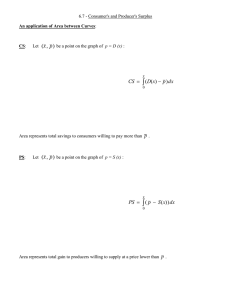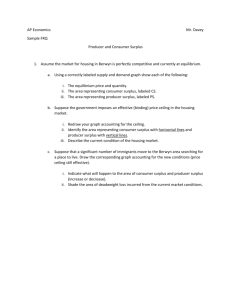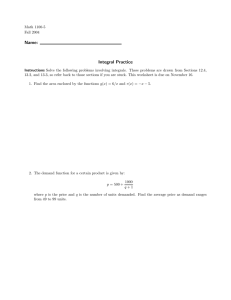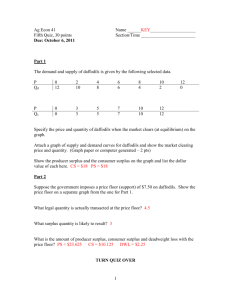Sloan School of Management 15.010/15.011 Massachusetts Institute of Technology
advertisement
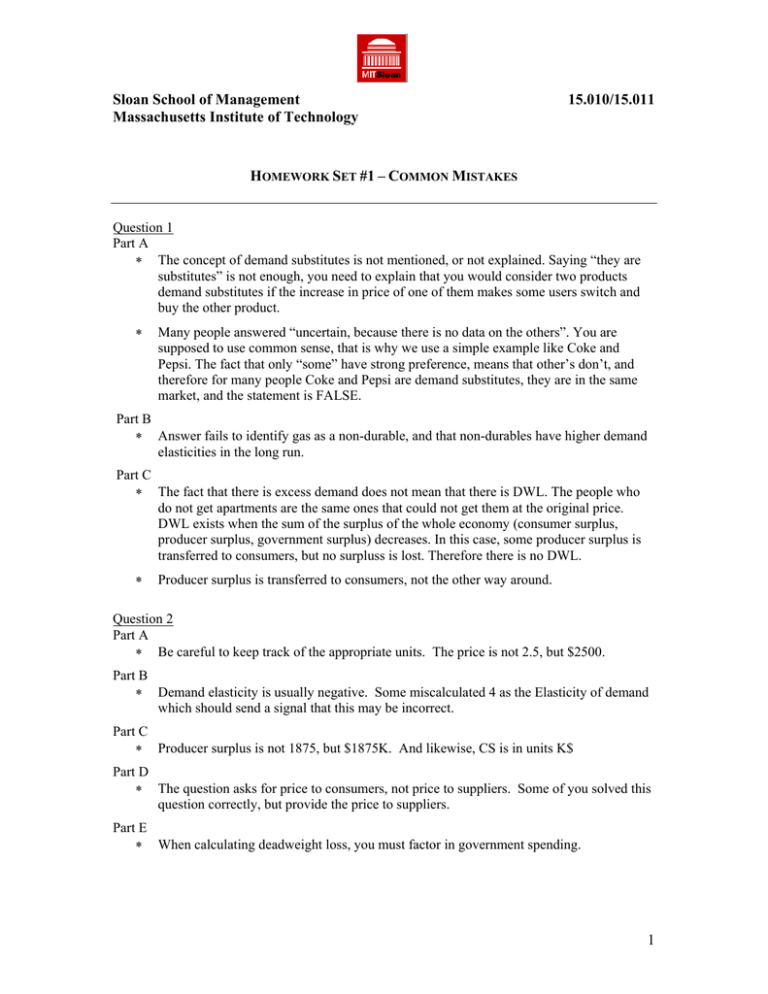
Sloan School of Management Massachusetts Institute of Technology 15.010/15.011 HOMEWORK SET #1 – COMMON MISTAKES Question 1 Part A ∗ The concept of demand substitutes is not mentioned, or not explained. Saying “they are substitutes” is not enough, you need to explain that you would consider two products demand substitutes if the increase in price of one of them makes some users switch and buy the other product. ∗ Many people answered “uncertain, because there is no data on the others”. You are supposed to use common sense, that is why we use a simple example like Coke and Pepsi. The fact that only “some” have strong preference, means that other’s don’t, and therefore for many people Coke and Pepsi are demand substitutes, they are in the same market, and the statement is FALSE. Part B ∗ Answer fails to identify gas as a non-durable, and that non-durables have higher demand elasticities in the long run. Part C ∗ The fact that there is excess demand does not mean that there is DWL. The people who do not get apartments are the same ones that could not get them at the original price. DWL exists when the sum of the surplus of the whole economy (consumer surplus, producer surplus, government surplus) decreases. In this case, some producer surplus is transferred to consumers, but no surpluss is lost. Therefore there is no DWL. ∗ Producer surplus is transferred to consumers, not the other way around. Question 2 Part A ∗ Be careful to keep track of the appropriate units. The price is not 2.5, but $2500. Part B ∗ Demand elasticity is usually negative. Some miscalculated 4 as the Elasticity of demand which should send a signal that this may be incorrect. Part C ∗ Producer surplus is not 1875, but $1875K. And likewise, CS is in units K$ Part D ∗ The question asks for price to consumers, not price to suppliers. Some of you solved this question correctly, but provide the price to suppliers. Part E ∗ When calculating deadweight loss, you must factor in government spending. 1 Question 3 Part A ∗ Remember that the equations used in Economics follow the form: Qd = a – b*P and Qs = c + d*P where P is the Y-axis and Q is the X-axis. The equations are not equivalent to the standard equation for a line (Y=mx+b). ∗ Additionally, the elasticities are NOT equal to the slope of the line and you cannot substitute the demand and supply elasticities for “b” and “d” respectively in the equations. Use the formulas: Price elasticity of supply: Ep = d*(P/Q) where Qs = c + d*P Price elasticity of demand: Ep = -b*(P/Q) where Qd = a – b*P Part B ∗ The problem asked “how will the tax affect consumer surplus and producer surplus. Although the question was worded poorly, what we were looking for was how much was the change in CS and PS (which can be numerically calculated). ∗ When graphing your supply curve from Part A, calculate where the curve hits the Y-axis by setting Q = 0. Do not assume that the supply curve goes through the origin. If you calculate consumer and producer surplus values from the areas on your graph, make sure your graph is correct. ∗ When calculating the effect on tax, the new price for the suppliers differs from the price for the buyers. You cannot just add the amount of the tax to the equilibrium price (i.e. $15 + $3 = $18) to find the new equilibrium price since we do not know how much of the tax burden is on the consumers vs. the suppliers. ∗ The decrease in CS and decrease in PS as a result of the tax includes both the surplus that is now government revenue AND the part that is thought of as deadweight loss. So, for the following graph (not drawn to scale), the decrease in consumer surplus is denoted by Areas A + B and the decrease in producer surplus is denoted by Areas D + C. The government revenue is Areas A + D and deadweight loss is Areas B + C. S Pd = $16 tax P* = $15 A B Ps = $13 D C D Q’=3.67 Q* = 15 Q (millions) 2



